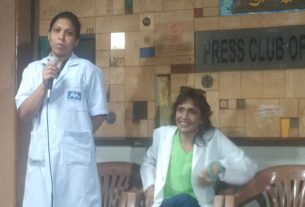JN Planetarium in the city pulled no stops to observe the phenomenon.
A tall stick placed at the centre of a platform was the centre of attention. Everyone was gathered around it and watched it with bated breath. As the sun moved across the horizon, the shadow of the stick kept getting shorter and shorter till it disappeared when the sun was at its zenith. It was Zero Shadow Day.
The Jawaharlal Nehru Planetarium in the city was filled with school students, academic communities, physics enthusiasts, and sundry passers-by who had come to watch their shadows disappear.
And, the Planetarium was all ready for it with equipment—new and old—that demonstrated and explained the science behind the phenomenon.
Anand, senior scientific officer and manager of the event in J N planetarium said that they had put out many exhibits including on-air instruments that would demonstrate the event. “We have a workshop for students who will measure the shadow length at various times. Using this, they will estimate the circumference of the Earth and also the speed of the Earth’s rotation.”
He added that this time they have added a radio telescope to add to the excitement. “As soon as the sun crosses the Meridian at noon,, when the sun is just in the zenith, it will start beeping. It will indicate that sun is on the Meridian,” he explained.
Pramod Galgali, Director of Jawaharlal Nehru Planetarium said that scientists from Bhopal and JN Planetarium are coordinating to share and find the reading, while explaining the concept of Zero shadow day to the school children. Using the reading they will be able to calculate the circumference of the earth, he added.
All the teams from across the country will do their research and share them. “I am happy to share the excitement of doing science is shared all across India,” Galgali said.
Prakash, father of two children coming from Sanjay Nagar said that he came to know about the event through his children. ”They wanted to come, and I tagged along with them,” he said.
Students from various academic communities were also present to witness the event. Dr. Sudharshan, National Coordinator for Advanced Learning Centre who came with his study group said that his students will be performing a live study in the planetarium by observing the sun’s movements.. “Our students will measure the length of the shadow and will notice that the shadow is becoming shorter as the sun goes to the noon position.” He said there will be no shadow when the sun is in the zenith. Sudharshan further added that Bengaluru, Mangaluru, and Chennai will also be able to witness this event.
“For people living between +23.5 and -23.5 degrees latitude, the Sun’s declination will be equal to their latitude twice – once during Uttarayan and once during Dakshinayan. On these two days, the sun will be exactly overhead at noon and will not cast a shadow of an object on the ground,” Astronomical Society of India noted.
To witness the event there were events planned at the Indian Institute of Astrophysics and in the J N Planetarium in Bengaluru.
This event happens twice a year when there is no shadow for any vertical object under the sun. This can be witnessed without any instruments, unlike other astrophysical events.







